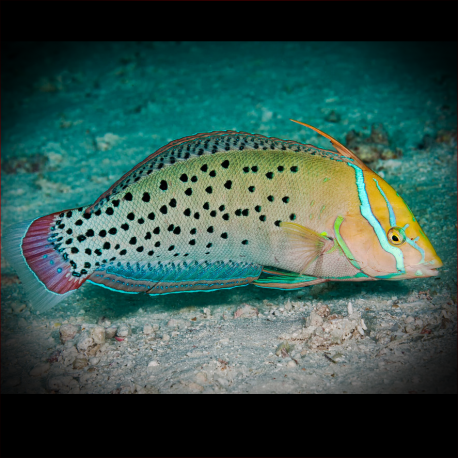More info
Datasheet
| Minimum Tank Size | 1500 litres / 396.26 US gallons |
| Maximum Size | 60.0cm / 23.62inches |
| Reef Compatible | Not reef safe |
| Temperament | Might be aggressive towards other species |
| Temperature | 22.2°C / 71.96°F - 25.6°C / 78.08°F |
| Specific Gravity | 1.020-1.025 |
| Carbonate Hardness | 8-12 |
| pH | 8.1-8.4 |
General Description
The Queen Coris, also known as Rainbow Wrasses, belong to the Labridae family and are native to the Western Indian Ocean, ranging from the southern Red Sea to Natal, South Africa, and east to Sri Lanka. These fish grow to a substantial size, with adults reaching up to 60.0cm in length. Their appearance undergoes a significant transformation from their juvenile stage to adulthood. They exhibit vibrant colors and are known for their habit of digging into the substrate when sleeping or feeling threatened.
Aquarium Suitability
Queen Coris are considered suitable for aquariums with caution. They are hardy fish but require a large tank, a minimum of 1500 liters, due to their eventual size. When fully grown, these wrasses can pose a threat to smaller fish, crustaceans, sea urchins, and even clams. They have a tendency to rearrange rocks and sand in the tank and should be monitored closely for aggressive behavior towards other species.
Care and Hardiness
Queen Coris are known for acclimatizing best when introduced to an aquarium at a young age. They require a deep sandy substrate of at least 2 inches for burrowing. These wrasses have a hermaphroditic nature, capable of changing from female to male. It's essential to provide them with a varied diet, including larger crustaceans, invertebrates, and small crustaceans like krill and mysis. They need plenty of space for swimming and prefer hiding when first introduced to a new environment.
Reef Suitability
Queen Coris are not considered reef-safe due to their tendency to disturb and hunt invertebrates found in reef setups. Their behavior of looking for food under loose objects can be destructive to coral and other reef inhabitants.
Aquarium Setup
When setting up an aquarium for Queen Coris, ensure a deep sandy substrate for burrowing and a securely placed rock arrangement to prevent toppling. Maintain water conditions with a pH level between 8.1-8.4, a specific gravity of 1.020-1.025, a temperature range of 22.2-25.6°C, and a carbonate hardness (kh) of 8-12.
Behaviour
These wrasses exhibit a behavior of hunting crustaceans, sea urchins, and worms within the aquarium effectively. They may display aggression towards smaller fish and have a tendency to nibble at clams, including Tridacna species. Queen Coris have a habit of hiding initially when acclimating to a new environment and rearranging rocks and sand in the tank.
Feeding and Diet
A recommended diet for Queen Coris includes larger crustaceans like shrimp and crabs, along with other invertebrates and small crustaceans such as krill and mysis. They must be provided with a varied diet to ensure their nutritional needs are met.
Dimorphism and Captive Reproduction
Queen Coris have the unique ability to change gender from female to male. In a captive setting, the species has been known to reproduce successfully under suitable conditions.
Habitat and Distribution
In their natural habitat, Queen Coris are found in the Western Indian Ocean, particularly in regions stretching from the southern Red Sea to Natal, South Africa, and eastwards to Sri Lanka. They prefer areas with sandy substrates where they can burrow and hide when needed.

